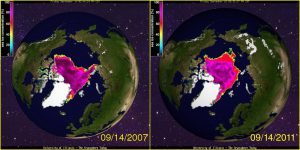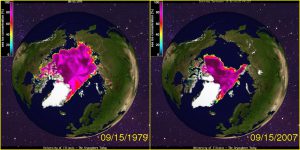Insights · November 9th, 2011

For some years now I’ve been sure to follow the summer-time story of ice in the Arctic Ocean, as tracked by the Snow and Ice Data Center in Colorado. I began doing this after meeting a cold-weather engineer from the U.S. Army Corps of Engineers, who alerted me both to the special dynamics of the Arctic, and to this Center as a reliable source of data. Because the global temperatures seem to be increasing in the Arctic at about twice the rate of the rest of the planet, the impact on the summer melting of the “permanent” ice cap can be dramatic. Detailed observations begin only in 1979, so the record is short, but in that time a significant increase in the summer melt has been observed, both in terms of the total area of ice, and its thickness. The composite satellite photos you may have seen measure only the area covered. Wind and short term weather patterns can impact the amount of ice observed – winds can push the ice in and out of the Arctic. If you study the data at the Center you will see that in general a pretty dramatic fall-off in the amount of ice at the end of each summer- mid-September – has been the pattern. 2007 was the summer with the least ice, and 2011 came in at second place. Looking at the satellite photos and the amount of clear water that enables ship navigation each summer now also illustrates why the nations that surround the Arctic are jockeying for position to open the Arctic to energy exploration. That tapping the fossil fuels that may be found there and lighting them on fire may only hasten the demise of the ice cap seems of secondary concern to those involved.

Is the Arctic a canary in the coal mine in terms of global impacts of climate change? I think so. I am surprised that it does not generate more attention.
When the subject of climate change comes up, I point everyone to visit this center online for themselves. The data and the photos are there for any one to see.
Yes, I know, if you compare 2007 to 2011 it will look like the ice is increasing! Trust me, it is not. Just visit NSIDC for the evidence.

